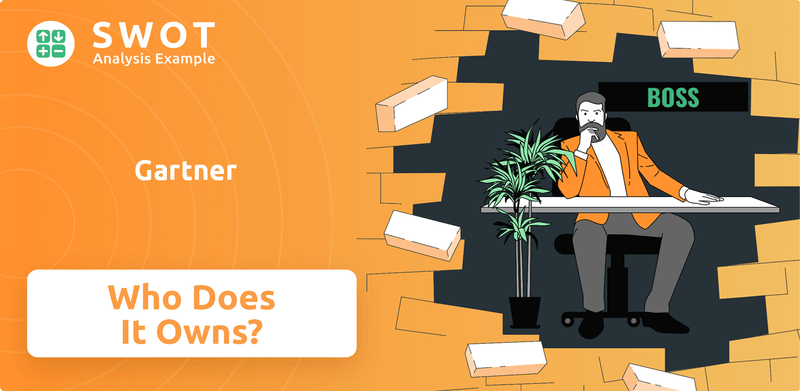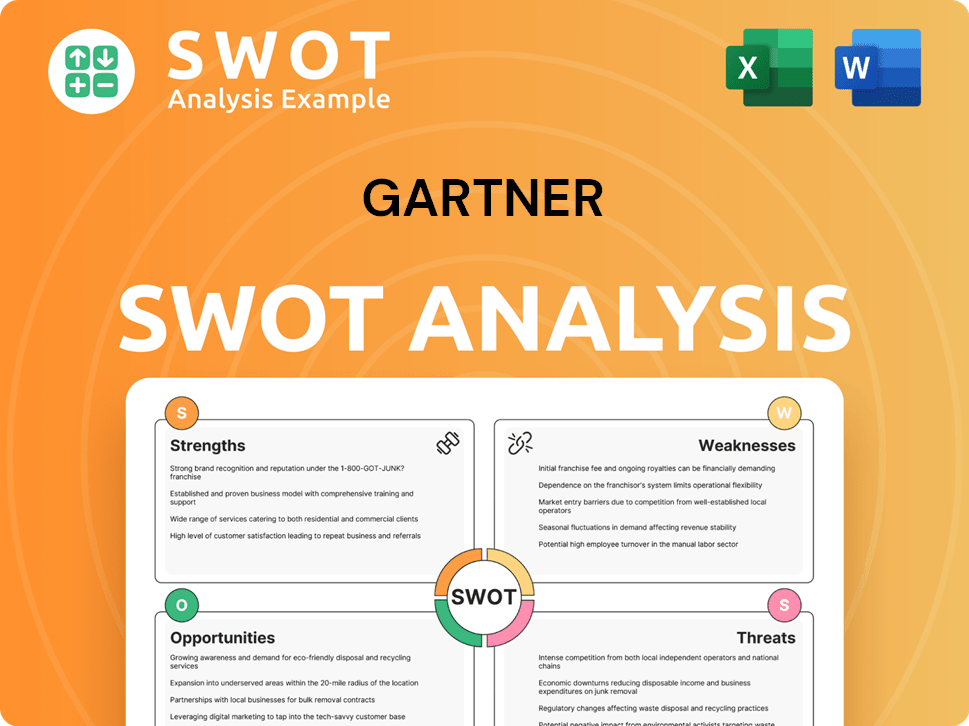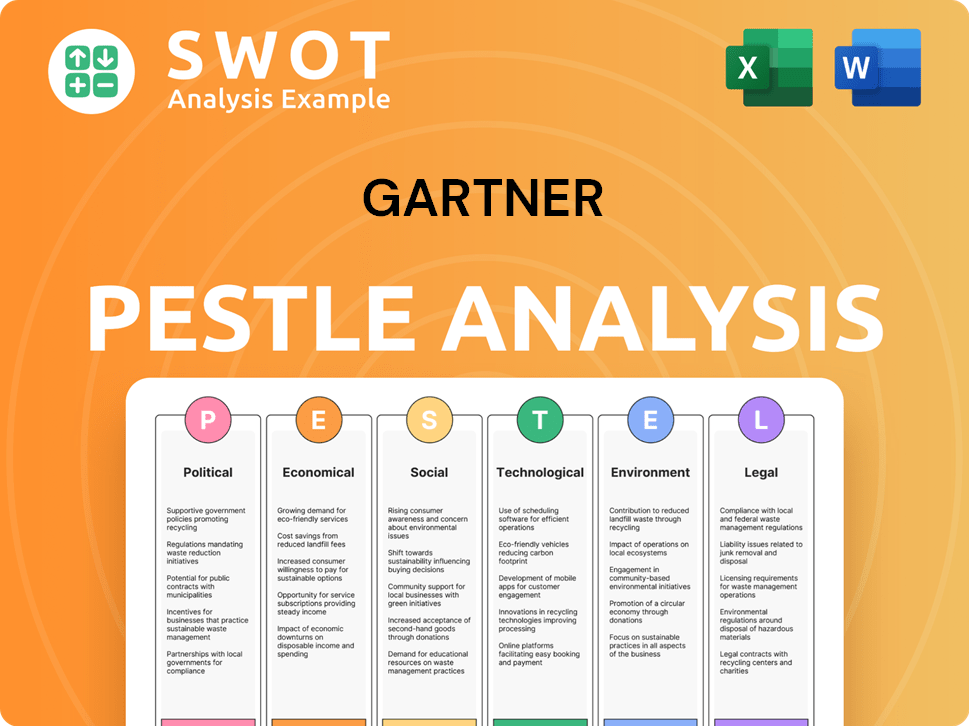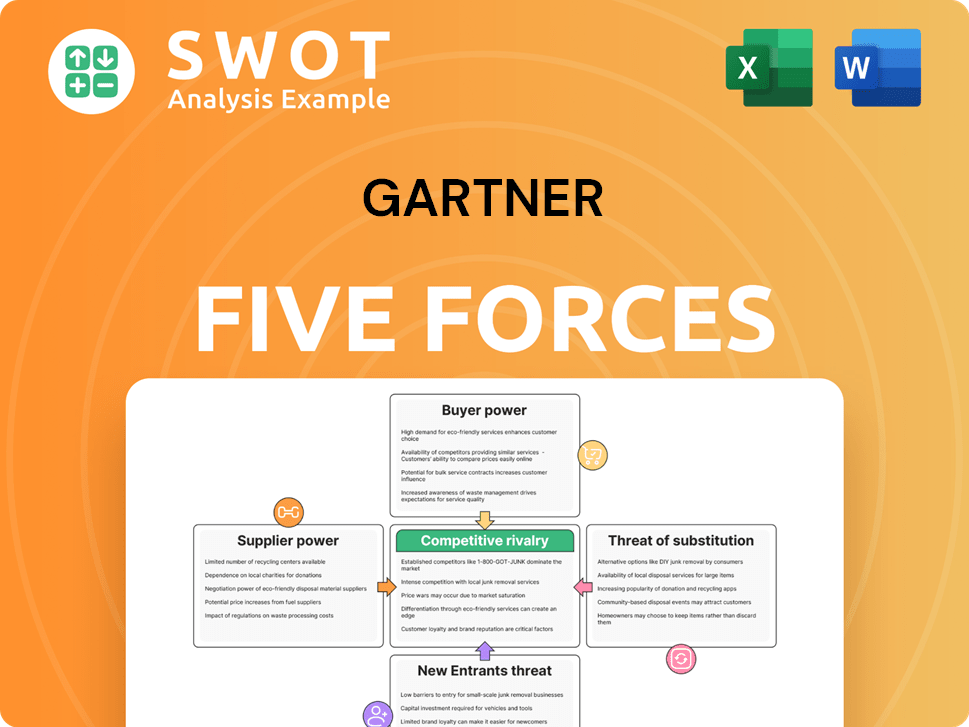Gartner Bundle
Who Really Owns Gartner?
Ever wondered who pulls the strings at a global powerhouse like Gartner? Understanding the Gartner SWOT Analysis is just the beginning. Knowing the Gartner ownership structure is key to understanding its market influence and strategic direction. This exploration will peel back the layers to reveal the individuals and institutions shaping the future of the Gartner company.

From its humble beginnings to its current status as a publicly traded giant, the Gartner company has undergone significant ownership shifts. Examining the Gartner ownership structure reveals a fascinating story of growth and adaptation. This analysis will uncover the key players, from Gartner shareholders to Gartner executives, who have shaped the company's trajectory and financial performance, including its impressive revenue growth.
Who Founded Gartner?
The story of the Gartner company began in 1979. It was founded by Gideon Gartner and David Stein, marking the start of what would become a significant player in the technology research and consulting industry.
Gideon Gartner, formerly an executive at IBM, saw an opportunity to provide businesses with specialized information about IBM and its products. David Stein, an executive at Harris Corp, joined him in this venture. Their combined expertise laid the foundation for the firm's early success.
Early reports from Gartner were concise, often presented as single-page documents that offered high-level insights. This approach helped the company quickly establish itself as a valuable resource for businesses seeking information and analysis in the rapidly evolving tech landscape.
By 1983, Gartner had expanded significantly.
The firm employed around 80 research analysts.
Revenue reached $8 million.
In 1985, the brokerage and investment division was spun off.
It became a wholly-owned subsidiary called Gartner Securities.
Later, it was renamed SoundView Financial Group.
Gartner Group went public in July 1986.
It was a significant step in its evolution.
This allowed for further expansion and investment.
The U.K.-based Saatchi & Saatchi acquired Gartner Group in 1988.
The acquisition price was approximately $77 million.
This marked a change in ownership for the company.
The early ownership structure evolved over time.
From the founders' initial vision to public trading.
Then, to being acquired by another company.
Gartner's early revenue growth was impressive.
From its founding to the mid-1980s.
This demonstrated the demand for its services.
The founders, Gideon Gartner and David Stein, played crucial roles in the company's inception. The early years saw rapid expansion, with revenue reaching $8 million by 1983. The spin-off of Gartner Securities and the subsequent acquisition by Saatchi & Saatchi marked significant milestones in the company's history. The company's evolution from a startup to a publicly traded entity and eventually to being acquired underscores its growth and changing ownership structure.
- Founded in 1979 by Gideon Gartner and David Stein.
- Expanded to 80 research analysts by 1983.
- Generated $8 million in revenue by 1983.
- Gartner Securities spun off in 1985.
- Rebranded as Gartner Group and went public in 1986.
- Acquired by Saatchi & Saatchi in 1988 for approximately $77 million.
Gartner SWOT Analysis
- Complete SWOT Breakdown
- Fully Customizable
- Editable in Excel & Word
- Professional Formatting
- Investor-Ready Format

How Has Gartner’s Ownership Changed Over Time?
The evolution of Gartner ownership has been marked by significant shifts since its inception. Initially acquired by Saatchi & Saatchi in 1988, the company was taken private in 1990 by Gideon Gartner and other executives with backing from Bain Capital and Dun & Bradstreet. This period, under Bain's ownership, saw a strategic refocus on IT industry pricing data, which helped expand profit margins. Dun & Bradstreet later increased its stake, acquiring a majority share in 1993.
Gartner returned to the public market in October 1993, with Dun & Bradstreet retaining a 50% ownership. During the mid-1990s, the company diversified its strategy through acquisitions and investments, including market research firm Dataquest and online news outlet TechRepublic. A major acquisition in 2017 involved CEB, a talent management and operations consulting firm, for $2.6 billion, which included $700 million in debt, to broaden its research and advisory services.
| Ownership Phase | Key Event | Impact |
|---|---|---|
| 1988 | Acquisition by Saatchi & Saatchi | Initial corporate ownership. |
| 1990 | Taken private by Gideon Gartner, Bain Capital, and Dun & Bradstreet | Refocus on IT industry data and profit margin expansion. |
| 1993 | Public offering with Dun & Bradstreet retaining 50% | Diversification and expansion through acquisitions. |
| 2017 | Acquisition of CEB | Expansion into talent management and operations consulting. |
As of June 2025, Gartner (NYSE: IT) is largely held by institutional investors, who control 93.78% of the company's stock. Insiders hold 182.93% of the shares, while retail investors hold 0.00%. Va Partners LLC is the largest individual shareholder, owning 51.23 million shares, representing 66.56% of the company, valued at $21.18 billion. Other significant institutional shareholders include Vanguard Group Inc., BlackRock, Inc., BAMCO, Inc., State Street Corp, and Fmr Llc. These major institutional investors have a substantial influence on the company's strategy and governance. Learn more about the company's background in this Brief History of Gartner.
Gartner's ownership structure has evolved significantly, from private equity to public ownership, with institutional investors now holding the majority of shares.
- Institutional investors hold a significant majority of the shares.
- Va Partners LLC is the largest individual shareholder.
- The company's history includes strategic acquisitions to expand its services.
- Understanding Gartner's shareholders and Gartner executives provides insight into its strategic direction.
Gartner PESTLE Analysis
- Covers All 6 PESTLE Categories
- No Research Needed – Save Hours of Work
- Built by Experts, Trusted by Consultants
- Instant Download, Ready to Use
- 100% Editable, Fully Customizable

Who Sits on Gartner’s Board?
The Board of Directors at the Gartner company plays a critical role in guiding the company's strategy and overseeing its operations. The board members are primarily responsible for making decisions that benefit the company and its shareholders. They meet regularly, holding four scheduled meetings each year to review financial performance, approve significant decisions, discuss corporate strategy, and receive reports from various committees.
Gartner has implemented a majority voting system for uncontested director elections. If a director doesn't receive a majority of the votes, they are expected to offer their resignation to the Board. The Governance/Nominating Committee then assesses the resignation and advises the Board, which must act on the recommendation within 90 days. This structure ensures accountability and responsiveness within the company's governance framework. As of the latest filings, Gene A. Hall serves as the Chairman of the Board and Chief Executive Officer, leading the board in its oversight responsibilities.
| Board Member | Title | Relevant Experience |
|---|---|---|
| Gene A. Hall | Chairman of the Board and Chief Executive Officer | Extensive experience in the technology research and advisory industry. |
| Michael D. Packer | Lead Independent Director | Experience in financial services and corporate governance. |
| Other Directors | Independent Directors | Diverse backgrounds including technology, finance, and consulting. |
The composition of the board includes a mix of independent directors and those with relevant industry experience. While specific details on individual board members representing major shareholders are not explicitly detailed in recent reports, the board's structure generally reflects a balance of perspectives. The company's bylaws outline procedures for director nominations and voting, ensuring a structured approach to governance and decision-making. For those interested in learning more about the company's history, you can find additional information by exploring the evolution of the company.
Gartner's Board of Directors is responsible for overseeing the company's strategic direction and ensuring shareholder interests are protected. The board's composition includes a mix of independent directors and those with relevant industry experience, ensuring diverse perspectives in decision-making.
- The Board holds regular meetings to review financial results and discuss corporate strategy.
- A majority voting system is in place for director elections.
- Gene A. Hall serves as the Chairman of the Board and CEO.
- The company's bylaws govern director nominations and voting procedures.
Gartner Business Model Canvas
- Complete 9-Block Business Model Canvas
- Effortlessly Communicate Your Business Strategy
- Investor-Ready BMC Format
- 100% Editable and Customizable
- Clear and Structured Layout

What Recent Changes Have Shaped Gartner’s Ownership Landscape?
Over the past few years, the focus on Gartner's growth strategy and its financial health has remained strong. In 2024, the
Gartner company
reported total revenues of $6.3 billion, a 6% increase compared to 2023. This financial performance reflects the company's continued success and market position. The company's commitment to its shareholders is evident through its share repurchase program, with approximately $735 million in stock repurchased in 2024 alone, and over $4 billion in the last four years. As of December 31, 2024, Gartner held $1.9 billion in cash and cash equivalents.Gartner's contract value, a key performance indicator, grew by 8% in 2024, reflecting the company's ability to secure and retain clients. The Research segment, the largest part of the business, saw revenues increase by 5% to $5.1 billion in 2024. The company's success in hosting in-person conferences, with over 86,000 attendees at 51 events in 2024, also highlights its strong market presence. These figures provide insight into
Gartner's financial performance
and its ongoing strategies.Industry trends, particularly in AI adoption, are significantly influencing Gartner's strategic direction. The company anticipates that by 2028, at least 15% of day-to-day work decisions will be made autonomously through agentic AI, up from 0% in 2024. This shift underscores the importance of AI governance platforms and securing machine identities in cybersecurity. These trends demonstrate how
Gartner ownership
is actively involved in guiding its clients through these technological changes, which impacts its investments and service offerings.| Metric | 2024 | 2023 |
|---|---|---|
| Total Revenue | $6.3 billion | $5.9 billion |
| Net Income | $1.3 billion | $915 million |
| Contract Value Growth | 8% | - |
Gartner's strong financial performance in 2024, with increased revenue and net income, shows its stability. The company's share repurchase program also indicates confidence in its financial position.
The growing focus on AI and its impact on various sectors influences Gartner's services. The company's strategic investments and service offerings are shaped by these technological shifts.
Gartner's actions, such as share repurchases, reflect a commitment to returning value to
Gartner shareholders
. This commitment helps maintain investor confidence.Gartner's predictions for AI adoption highlight its importance in the future. This focus guides the company's strategic investments and service offerings.
Gartner Porter's Five Forces Analysis
- Covers All 5 Competitive Forces in Detail
- Structured for Consultants, Students, and Founders
- 100% Editable in Microsoft Word & Excel
- Instant Digital Download – Use Immediately
- Compatible with Mac & PC – Fully Unlocked

Related Blogs
- What are Mission Vision & Core Values of Gartner Company?
- What is Competitive Landscape of Gartner Company?
- What is Growth Strategy and Future Prospects of Gartner Company?
- How Does Gartner Company Work?
- What is Sales and Marketing Strategy of Gartner Company?
- What is Brief History of Gartner Company?
- What is Customer Demographics and Target Market of Gartner Company?
Disclaimer
All information, articles, and product details provided on this website are for general informational and educational purposes only. We do not claim any ownership over, nor do we intend to infringe upon, any trademarks, copyrights, logos, brand names, or other intellectual property mentioned or depicted on this site. Such intellectual property remains the property of its respective owners, and any references here are made solely for identification or informational purposes, without implying any affiliation, endorsement, or partnership.
We make no representations or warranties, express or implied, regarding the accuracy, completeness, or suitability of any content or products presented. Nothing on this website should be construed as legal, tax, investment, financial, medical, or other professional advice. In addition, no part of this site—including articles or product references—constitutes a solicitation, recommendation, endorsement, advertisement, or offer to buy or sell any securities, franchises, or other financial instruments, particularly in jurisdictions where such activity would be unlawful.
All content is of a general nature and may not address the specific circumstances of any individual or entity. It is not a substitute for professional advice or services. Any actions you take based on the information provided here are strictly at your own risk. You accept full responsibility for any decisions or outcomes arising from your use of this website and agree to release us from any liability in connection with your use of, or reliance upon, the content or products found herein.